I’m excited to launch something new: Google Ads Aces.
It’s a show where I take a look at the Google Ads performance of some of ecommerce biggest and hottest brands.
We’ll take a look at what they’re doing, what they’re doing well, what not so. As always, the goal is to get smarter and get ideas that we can use in our own campaigns.
In this episode, I’ll take a look at Allbirds, a shoe company that raised $77.5M in VC funding!
What are they doing when it comes to Google Ads? How much are they spending? Is it working? And are they able to fight off competitors?
You’ll find out in this post. If you prefer the video version:
Table of Contents
Allbirds?
Allbirds sells eco friendly minimalist shoes.
The company sprouted from a successful Kickstarter campaign back in 2014 and is now selling a whole range of men’s and womens shoes.
The last couple of years a lot of these new shoe brands have started. Another brand that you might know that sells similar shoes is Inkkas.
And a lot of these competitors have pulled in massive amounts of VC money. Allbirds has raised a whopping $77.5M.
As with most B2C brands, most of that raised money is plowed into customer acquisition. And more specifically into ads.
It’s hard to get an exact number, but people in the industry estimate Allbirds spends about $100-500k/mo on advertising.
Most of it on Facebook and Instagram.
In what follows, we’re going to focus almost exclusive on the Google Ads efforts of Allbirds.
If you’d like a broader perspective at what Allbirds is doing marketing wise, have a look at this SmartMarketer analysis.
Here is what I’ll cover:
Allbirds Google Ads Overview
Despite the huge budgets plowed into Facebook and Instagram, Allbirds spend a lot less on Google Ads.
To my estimate, Allbirds spent about $25-35k/mo on Google Ads (research from October 2018). Here is how that breaks down:
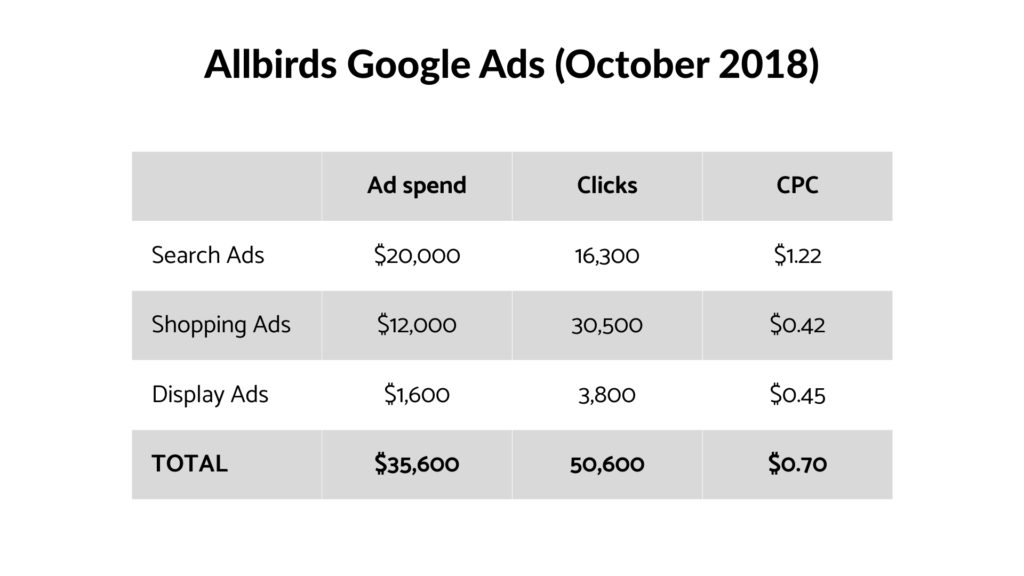
The trend is also going up leading up to the 2018 holiday season.
Allbirds Search Ads
Search Ads spend: $20,000
- Spend: $20,000
- Clicks: 16,300
- CPC: $1.22
Allbirds has a very strong brand. When it comes to organic search, about 90% is branded traffic.
Branded paid search
So the branded search campaigns can simply benefit from all the other brand awareness efforts that Allbirds is doing.
A strong brand means low CPCs ($0.1-0.5/click), which means it’s pretty easy to run these campaigns and achieve a very good return on ad spend (ROAS).
A common question I hear from people new to Google Ads is why spend money on sales that would come in anyway?
So why would Allbirds run ads on their own branded keywords?
The most important reason is to block competitors from advertising on “allbirds” related keywords. Many of Allbirds competitors are extremely well funded, and many of them wouldn’t hesitate to burn money just to get visibility.
Because the way Google Ads works, advertising on the “allbirds” keywords is a lot more expensive for a store that doesn’t sell Allbirds products. So competitors will pay anywhere form 3-10x that CPC, which ranges from $0.75-$5. At this scale, these campaigns can blow through a lot of money quickly.
Branded keyword overview
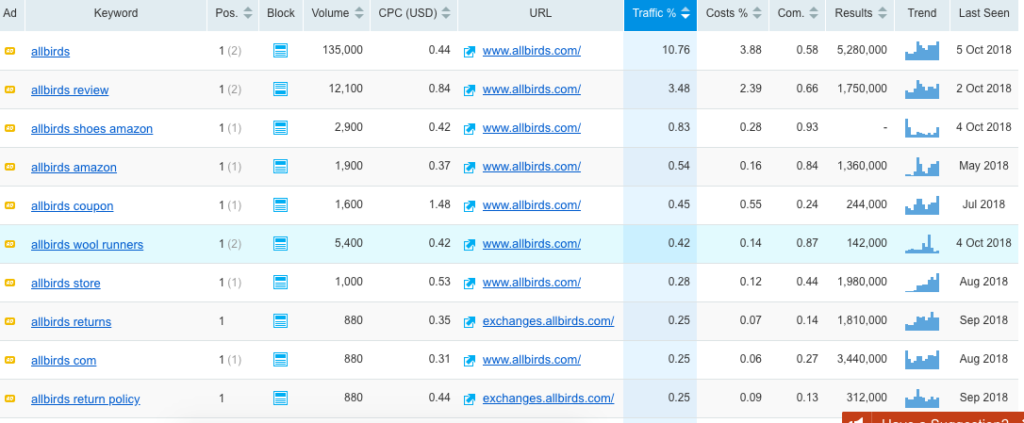
Observations:
Most of these search queries are pretty much what you would expect: majority traffic on the exact brand name with some other combos.
The second most searched term is “allbirds review”. This is interesting because Allbirds doesn’t actually have any reviews on their site (I’ll come back to this later).
Interestingly, there is a lot of search traffic for “allbirds amazon”. Allbirds only sells their products on their own site. So they want to make absolutely sure that no one ends up on Amazon where they might find comparable or cheaper shoes.
From this list comes a second interesting benefit from running ads on your own brand name: you have more flexibility when it comes to your ads and their landing page.
This can be great if you’re launching new products: you can instantly send people to your newest product without waiting for SEO to kick in.
Allbirds leverages this in an interesting way for two keywords with some traffic:
- Allbirds returns
- Allbirds return policies
Allbirds offers free shipping and free returns. So since that’s a vital part of the experience, they want to provide a good service to make these returns simpler.
To do that, they have a dedicated subdomain to handle these exchanges:
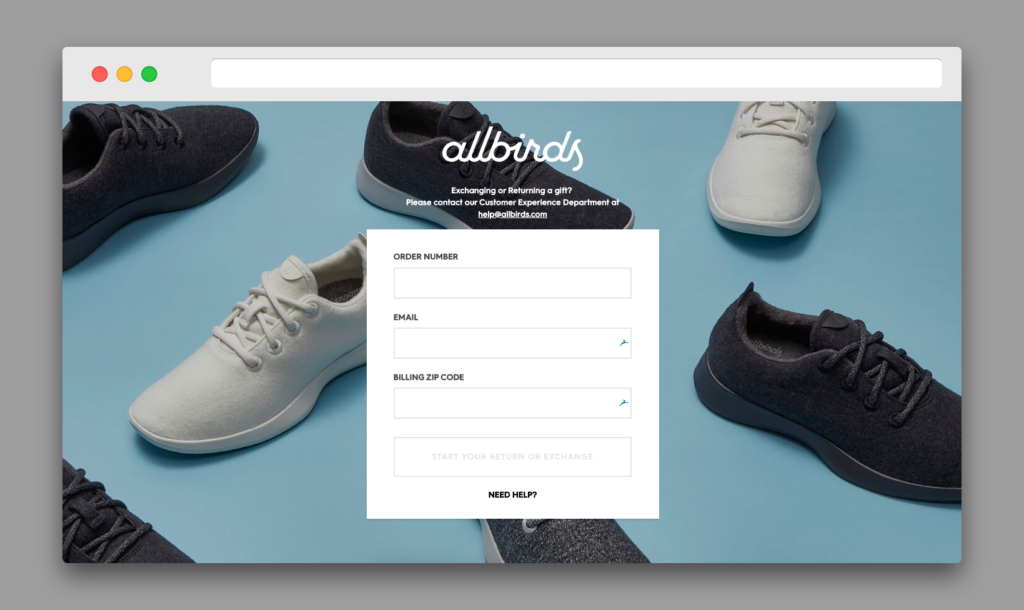
Non-branded paid search
This is where things get interesting 🤓
The branded campaigns tap into the other marketing efforts.
But the non branded searches will need to work a lot harder on attracting people to the site and convincing them to buy.
Let’s start by looking at looking at a sample of the top non branded keywords:
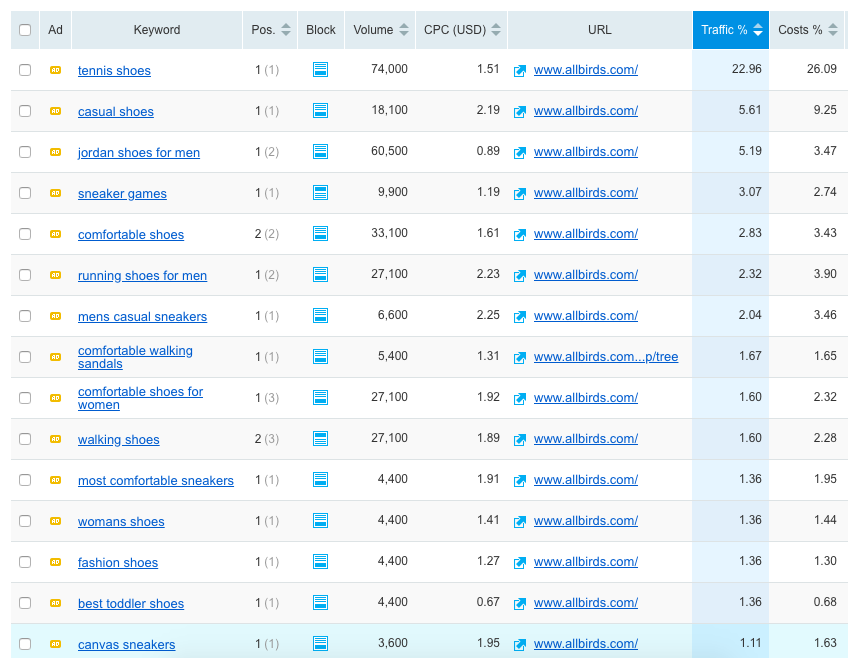
The above list represents about 40% of all non-branded paid search queries to allbirds.com.
Observations:
“Womans shoes” or “fashion shoes” seem way too broad to convert. “Tennis shoes” and “running shoes” are a bit better, but should be closely tested. Longer tail variations of these keywords probably perform better.
The other keywords in the list are keywords you would probably think about when looking at Allbirds products.
But 2 keywords in the above list seem off: “jordan shoes for men” and “sneaker games”.
This is usually the part where the gap widens between venture backed ecommerce businesses (with too much money to spend), and those that fund their growth from their revenues.
I’m pretty confident that advertising on “jordan shoes for men” doesn’t give them a sufficient direct return. The gap between what people are looking for vs what they are actually seeing, the allbirds.com homepage is too large.
Maybe this is a conscious effort to target other types of shoes that have an overlap in customers? And by advertising on it they are gunning to become part of the consideration set. In that case it’s a gamble and long term play that can be quite expensive.
But more likely, the jordan keyword slipped into their account without them being aware. Same goes for search terms like “sneaker games’ and “average shoe size by age”
These do not match with their products.
From the outside, it’s hard to know exactly what’s going on or exactly how the campaigns are configured.
But the most common explanation is broad match types.
People new to advertising or those of us with too much money to spend, are very generous match types, this causes all kinds of search queries to be included that should be avoided. (Like “sneaker games”)
Another explanation for including a lot of keyword variations is that they want to continue their keyword research. But just that Jordan keyword is appearing for about $700/mo. So it wouldn’t hurt them to keep a closer eye on their search terms report.
Allbirds ad groups
Something that’s key when starting an account like this is to group keywords into themed ad groups.
Going through the rest of the list of keywords, the following themes emerge:
- Tennis shoes
- Running shoes
- Comfortable shoes
- Travel shoes
- Walking shoes
- Sneakers
- Slip on shoes
- Wool shoes
- Wool runners
This is a very simplistic version of the actual structure of the actual Allbirds Google Ads account, but the reason to group them is to create specific ads based on the theme.
Someone looking for “tennis shoes” will have different expectations vs someone looking for “womans shoes”. The ads are key to address those differences.
Allbirds text advertisements
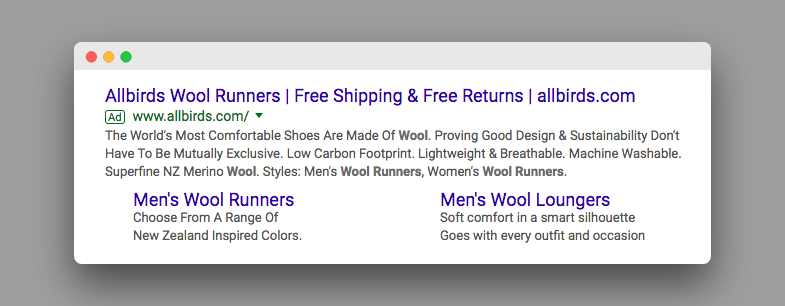
Next to creating ads that reflect the actual intent of the person searching, ads also have to stand out and sell the product.
Allbirds does this by working on a couple of different angles: sustainability, design, quality and being super comfortable.
This last one is a pretty interesting one. In their ads, they use the line “The World’s Most Comfortable Shoes”. This is an actual quote from a time.com review. And it’s something they’re using now as part of their brand:
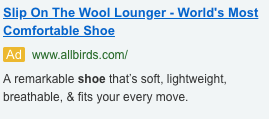
When it comes to sustainability, they are testing a variety of phrases in their ads:
- Sustainability Meets Style
- Low Carbon Footprint
- Environmentally Friendly Shoes
- Made With Sustainable Wool
This is good, keep testing different phrases to see which ones resonate best with certain keywords.
When it comes to creating ads for non-branded search, a common practice is to repeat the exact search query as the headline of the ad. But how do you combine that with your own brand (and maybe triggering a vague memory in your prospect’s mind?)
Here is the headline from an ad that appear when someone searches for “ethically made running shoes”:
Eco Friendly Allbirds Shoes – Made With Sustainable Wool
Note how the Allbirds brand is added in there. This make it a lot stronger headline compared to:
Eco Friendly Shoes
This is something they are doing through the account: “Allbirds Running Shoes” vs “Running Shoes”.
They are running ads on a couple of their competitors. Here is the headline that appear when someone searches for “paragon chappals for mens”.
Better Shoes In A Better Way | Allbirds Wool Shoes
This is a pretty good competitor ad. It doesn’t try to confuse the person searching, just to show that there is an alternative.
They are also testing a small hack that can work well to improve your clickthrough rate: the copyright/trademark hack. Simply add a symbol behind your brand name to make it stand out:
Allbirds® Official Site | World’s Most Comfortable Shoes
Adding “Official Site” or “Official Store” can also work.
Besides the headline testing that Allbirds does, the description text are also well put together. They are including a lot of what I call Sales Boosters, phrases that are action oriented. Things like:
- Shop Allbirds now!
- Get your Allbirds today!
- Order now.
- Free Shipping & Returns!
- Try Them Free For 30 Days.
- Get your’s today!
- Try Them!
Allbirds ad extensions
Ad extensions make your real estate bigger, so it’s always good to add them to your account and see which ones perform best. Allbirds is using most of them: sitelinks, callout extensions, structured snippets
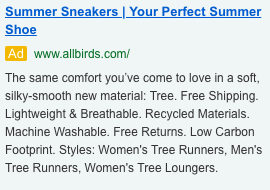
Some examples:
Callout extensions: Machine Washable. Superfine NZ Merino Wool. Free Returns. Low Carbon Footprint. Free Shipping. Lightweight & Breathable. Free Returns. Recycled Materials. Free Shipping. Superfine NZ Merino Wool.
Structured snippets:
- Styles: Men’s Wool Runners, Women’s Wool Runners, Men’s Wool Loungers.
- Styles: Women’s Tree Runners, Men’s Tree Runners, Women’s Tree Loungers, Men’s Tree Loungers, Women’s Tree Skippers.
The missing one are seller ratings or star ratings. As I mentioned before, allbirds.com doesn’t have any review on the site. These are essential is you want those star ratings to show up.
For branded searches they won’t have that many impact. But on on-branded searches, when people haven’t heard about you, or are still researching, a solid amount of good reviews can go a long way.
Allbirds landing pages
Most of the traffic goes to the homepage and a few ads go to the product detail pages.
You heard a lot of negative things about using the homepage as the destination page for your ads, but that really depends.
In this case, the Allbirds homepage is very solid. It sells the brand and product very well:
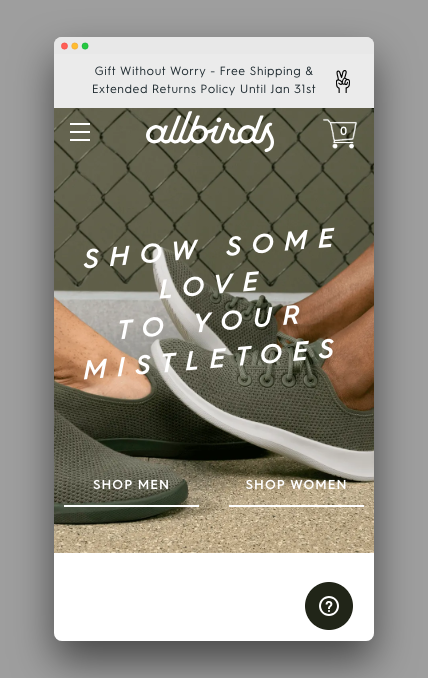
For a brand of their size, I have no doubt that they are constantly running tests to see which page performs better.
Allbirds Shopping Ads
Shopping Ads overview:
- Spend: $12,000
- Clicks: 30,500
- CPC: $0.42
Figuring out the tactics from the outside isn’t easy when it comes to Google Search Ads. And doing that for Shopping Ads is even harder.
Since I love Shopping Ad, and their increasing importance, I can’t skip them. So in what follows I’m going to comment on what I can see, and give an overview of how I would ensure the best possible results.
Allbirds Shopping search queries
Let’s start with an overview of the search queries with the highest search volumes that their ads appear for:
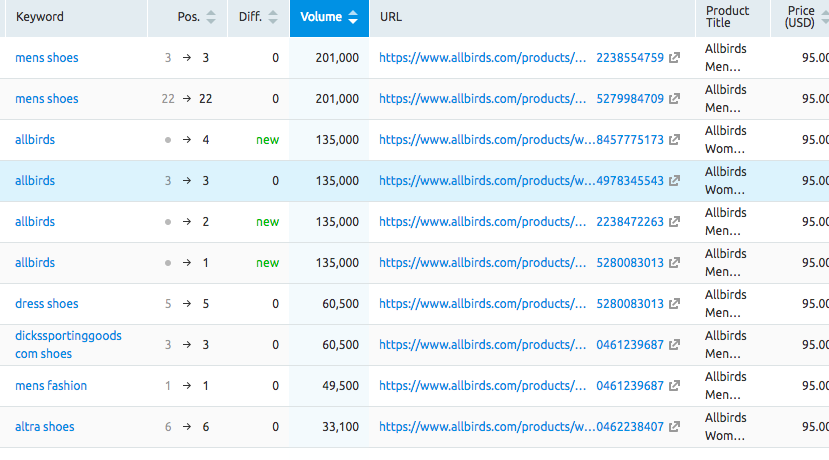
2 comments on the table above:
- The volume column is the total search volume, not the amount of traffic that Allbirds pulls in from these searches
- Duplicate keywords mean that different products can come up for the same keyword. Especially with a search like “allbirds”. It’s unclear if the searcher wants to see a shoe for men or women. That’s why Google shows a few different products.
Allbirds Shopping campaign structure
Looking through that list, a structure emerges for the campaigns:
- Branded search queries
- Related product queries
- Other product queries
Note that here the “analysis” part, becomes more a “here is how would run these campaigns” part.
Campaign 1: branded search queries
Like we saw with the search campaigns, there are tons of searches for the allbirds brand name.
These need to be put into a specific campaign and if we put each of the shoes in a different ad group we can monitor the performance of specific products. This can answer a question like:
Which products should be displayed when someone searches for “allbirds”?
Product level ad groups will allow them to see which products have the best CTR and which convert best.
Campaign 2: related product search queries
The next group of search queries, the isn’t presented in the list above. That’s likely because the search volumes are so much lower.
But again we can assume that the product listing ads will appear for similar queries to the search campaigns.
For this group, we’re interested in search queries that are related to the actual products. Searches like: comfortable shoes, casual, casual sneakers, wool runners etc.
The chance of converting these visitors is a lot higher than someone searching for “means fashion”. Putting these into their own campaigns will allow Allbirds to bid higher.
Campaign 3: Other product search queries
The third group will target all the remaining search queries. These are the very broad one like “mens shoes” or “mens fashion”.
These search queries are very tough to profitably advertise on. That’s the search volume is very high, so if you are there with your ads you will quickly burn through a ton of money for visitors that aren’t likely to convert.
But if you know you can convert these visitors, and get a sense of the conversion rate for this traffic, you can set the right bid.
This 3-campaign setup will allow them to bid the correct amount for each search query.
The real Allbirds Shopping campaign structure is probably a lot more complicated, but it would follow the approach described above, but more granular. Like 3 campaigns for mens shoes, 3 for womens shoes, etc.
Group 4: negative keywords.
Not really a campaign, but a bonus group of keywords also emerges from that list, the one that are totally irrelevant.
These search queries should be added to the negative keywords. From the list above:
- dress shoes
- dickssportinggoods com shoes
- altra running shoes
Allbirds Product Listing Ads
With Shopping Ads, you don’t have any control over what the actual ads look like.
The only things that you can do to change the default appearance are: adding Seller ratings, adding a Promotion in Google Merchant Center or lowering your price.
As we’ll see below, Allbirds has a strict policy against discounts, so the latter two Shopping Ads tweaks aren’t available.
Seller ratings, the star ratings that are added to an ad, are again missing. As I said in the Search ads section, adding these can work wonders to get a performance boost from the ads targeting the non-branded search queries.
Allbirds Display Ads
In the past, Allbirds ran display campaigns to cold audiences. Probably timed together with the launch of a new collection or series of products.
Here are some examples:
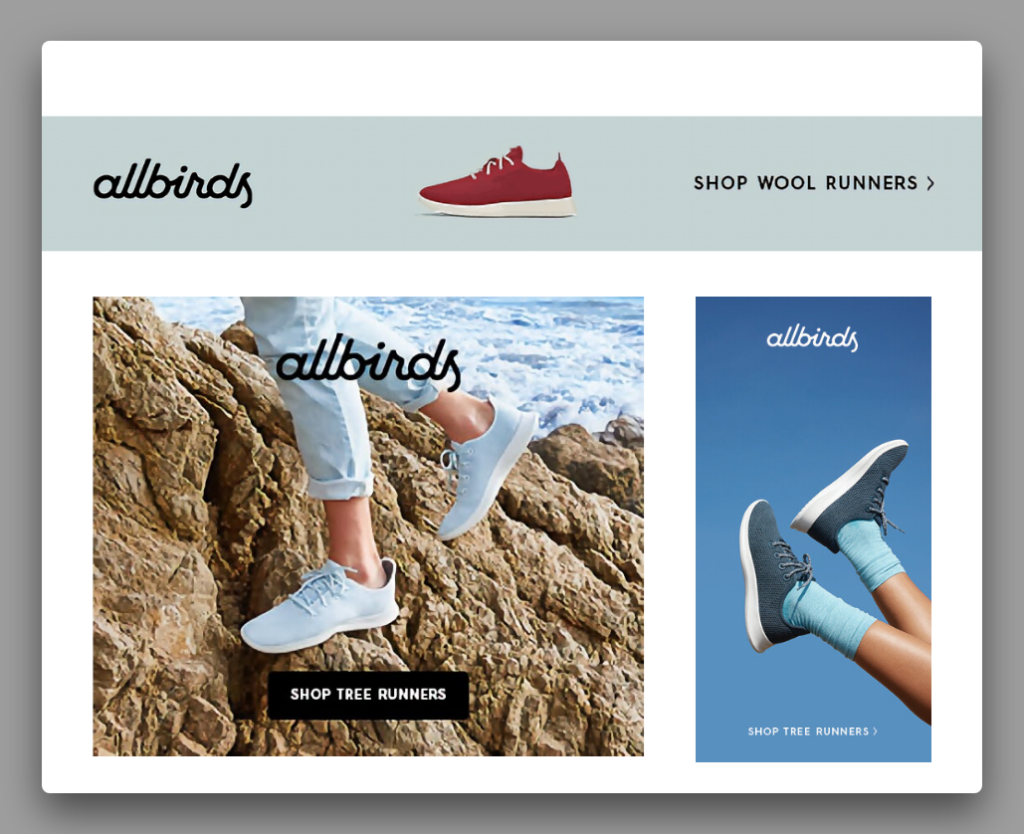
As of today, Allbirds doesn’t run these ads anymore. Currently their display campaigns are limited to dynamic remarketing. These are campaigns that show a carrousel of ads to people that have visited the site:
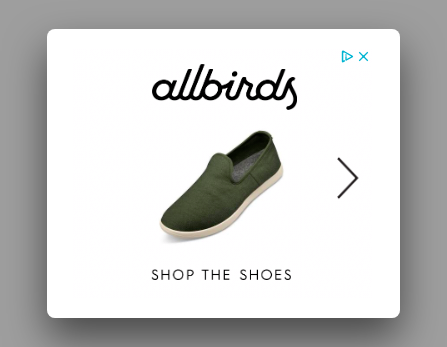
These usually are a good way to recapture some sales and are also great from a branding perspective. The ads look very simple and clean, with the brand name well visible 👌
The Scoreboard
The Scoreboard brings together all of the research and analysis and attempts to ballpark Allbirds’ actual profit numbers.
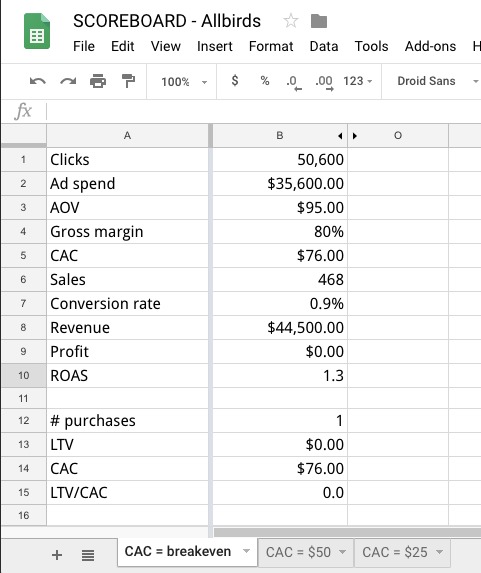
First we start with the numbers from the research:
(If you’re interested in the actual Google Sheet, click here to get it)
Clicks, ad spend came from the research, the other numbers are (well?) informed assumptions.
Model 1: No profits
The most important ones are the 80% gross margin (which isn’t unlikely for a product like Allbirds’ shoes) and the Customer Acquisition Cost (or CAC) of $76.
At this CAC, no profit is made and all the money being generated by sales is put into customer acquisition.
The model above also assumes that these customers purchase exactly ONCE.
That means that the Lifetime value (LTV), the amount of profit an Allbirds customer generates, is $0.
The next metric to call out is the LTV/CAC ratio. This metric is one that’s often used to describe the effectiveness of a business with a recurring component like returning customers or Saas software.
While important to monitor internally, this metric is very important when you’re looking to raise new funding from investors.
Allbirds raised $50 million of additional funding in late 2018 was to grow faster. Sources also reported that the company was profitable in 2016 and 2017.
I believe this means that they have a working business model.
In the venture capital world, that means a LTV / CAC ratio (well) above 3.
In what follows we’ll try to get to that number by playing with my assumptions above.
Model 2: Returning customers
First, let’s see what happens when these customers come back to purchase additional products:
The only thing that changes in the columns to the right are the number of purchases/customer.
To hit a LTV/CAC ratio of 3, each customer has to order 3 extra pairs after their first purchase.
That’s clearly a bit of a stretch, so let’s see what happens if Allbirds can take the CAC from $76 to $50.
Model 3: CAC of $50
The only thing that has changed in the table above is the CAC that went from $76 to $50.
For this model to hit a LTV/CAC ratio of 3, every customer would need to purchase an additional 1.6 pairs of shoes on top of their first purchase.
Still highly unlikely, so let’s decrease the CAC even further.
Model 4: CAC of $25
Below is the same table, only the CAC went from $50 to $25:
These numbers start to make a lot more sense. For this model to be accurate, customers need to purchase an additional 0.3 pairs of shoes. This is a repurchase rate that well-run ecommerce businesses should be able to hit.
Takeaways
The Scoreboard shows that achieving a low customer acquisition cost is key.
So if we frame the findings of this article in that light, here are some takeaways from the Allbirds Google Ads campaigns:
Search Ads:
- Keyword: keyword match types and search queries need to be reviewed to cut wasted ad dollars
- Ads: very good, lots of different copy and ideas in the ads
- Ad extensions: missing seller ratings/reviews that can help increase conversion rate
Shopping Ads:
- Improve the account structure to do search query filtering
- Target more specific and valuable search queries
That’s it for Allbirds!
I would love to hear your feedback and suggestions in the comments. If you have a brand in mind that you want this see this kind of analysis of, let me know!
Read our other breakdowns: Purple – MVMT – Judy – Away – Glossier – Ritual – Caraway – FIGS




Hi Dennis, love this kind of thing. Keep them coming. It’s pretty hard, as you say, to know exactly what’s going on but you’ve made a pretty good effort as far as I can see. Never heard of this company, will keep an eye out in case they appear in the UK.
Cheers, Dan
Hi Dan,
Glad to hear you enjoyed it 😊 Let me know if you have any brands you’re interested in. Goal is to cover brands in different markets and industries!
Cheers very intersting !
Really interesting article … thank-you
Glad you enjoyed the video/article Kate!
Very interesting! Love the straight forward approach with exact scenarios. Thanks Dennis
Glad you found it useful Mujtaba!
Sorry – I realize you are focusing on the google ads portion specifically, and its a good article for showing how that works. Online marketing is just frustrating because these start up stories are part of the marketing and they dont really want to tell you how they really did it or it would lose some of its luster. Its all about luster. Would allbirds still be allbirds without spending a dime on google ads – yes, probably – it increases their sales a bit perhaps, but its not the reason they are popular in the first place. Anyway, Cheers.